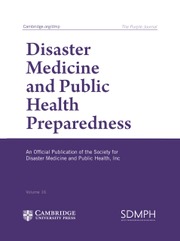The deliberate targeting of healthcare infrastructure and healthcare workers (HCW) in contemporary conflicts represents a collapse of respect and adherence to International Humanitarian Law (IHL) and, through this, poses a crisis for humanitarian health care. The massacre at the Saudi Hospital in El-Fasher, North Darfur, by the Rapid Support Forces (RSF) in October 2025, serves as the latest, stark evidence of this deliberate tactic to destroy a population’s health system. With attacks on facilities doubling and over 900 health workers killed globally in the preceding year, 1 existing protections, including United Nations (UN) Security Council Resolution 2286, are demonstrably failing to deter aggressors.Reference Bellizzi, Pichierri and Farina 2 Immediate, international action, robust accountability, and security are needed to end impunity and reaffirm the fundamental inviolability of health care and medical services in conflict and humanitarian settings. 3 , Reference Siem 4
Reports corroborated by satellite imagery confirming mass killings near medical sites underscore that hospitals are no longer sanctuaries; they are strategic military objectives to be eliminated. 5 This crisis is global and accelerating. In Sudan alone, 244 attacks, including the killing of 66 health workers, were reported prior to the El-Fasher incident, illustrating a pattern of targeting and destruction. 6 , Reference Mahase 7 This violence is not collateral damage; it is a deliberate tactic of warfare designed to strip civilian populations of their means of survival, facilitating forced displacement and population control. 3
International legal frameworks, though robust on paper, have failed to enforce the protection or security of healthcare. Resolution 2286 (2016) of the UN Security Council strongly condemned these attacks and mandated state action. 8 The intentional directing of violence against civilian infrastructure, including hospitals, constitutes a war crime under customary IHL. 8 Yet, the increase in attacks since shows broad inaction and widespread impunity.Reference Bellizzi, Pichierri and Farina 2 The human impact and public health consequences are devastating and enduring. Beyond immediate trauma casualties, the destruction leads to medicine shortages, the collapse of chronic care (as seen in Khartoum), 9 and the systemic erosion of community trust required for future public health initiatives, such as vaccination campaigns.Reference Mahase 7
To reverse this trajectory, the global community must act upon the purpose and intent of established IHL and the Geneva Conventions. UN Member States should establish transparent, mandatory sanction mechanisms tracing the funding of perpetrators of verifiable attacks on HCWs. Travel restrictions and other economic penalties are tools that can be deployed against individuals and responsible groups beyond the legal process to dissuade these attacks. Non-government organization benefactors, sponsors, or patrons are urged to join the UN, government health authorities, and health care administrators to seek meaningful deterrents. Technology can be developed and deployed to prevent “mistake” attacks from the air. Confidential communication processes can be established for health care workers to report to the UN or other humanitarian agencies when their facility is being used as a shield from combatants. Philanthropic efforts to protect healthcare workers should be held in the same regard as delivering healthcare to those in conflict and humanitarian settings. Standing idle is not an option because there are no easy solutions. Enough is enough, the time is now, a non-negotiable imperative for civilization.

